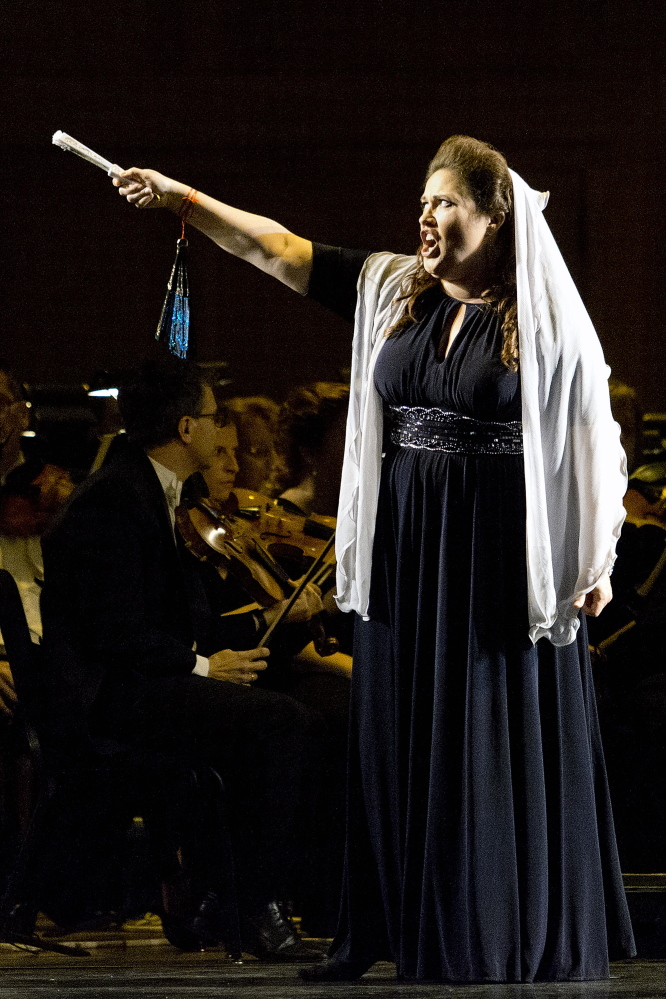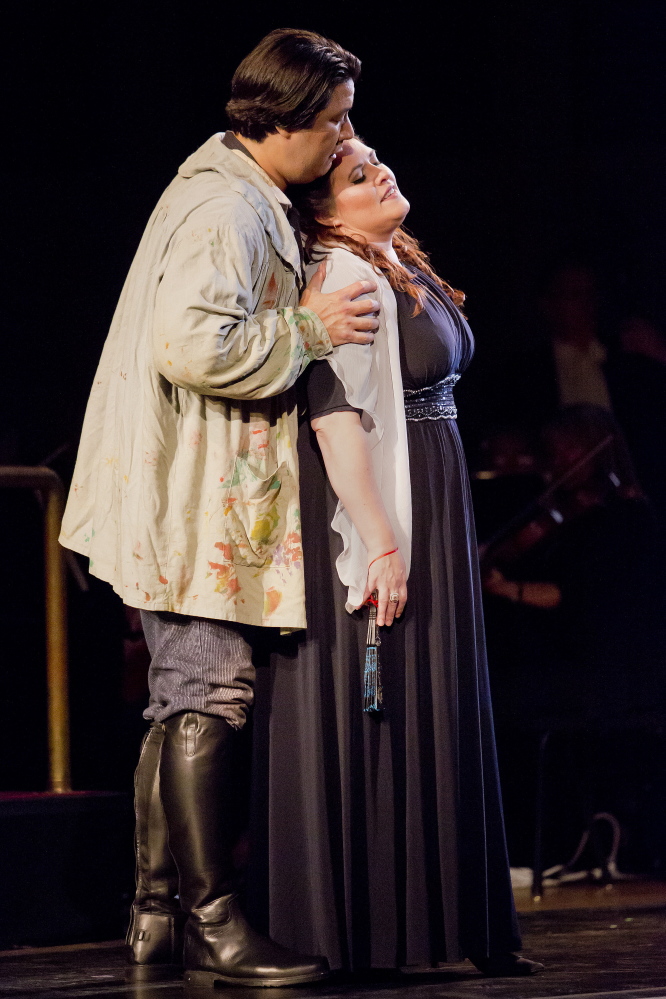For anyone inclined to fret beforehand about an opera production’s possibilities, PORTopera’s “Tosca” offered plenty to worry about. There was the casting, for starters. James Morris, long a Metropolitan Opera mainstay, would be singing the villainous Scarpia, and Thomas Hammons, a great character actor, would take on the Sacristan, a small, semicomic role. But the Tosca and Cavaradossi, would be sung by Alexandra LoBianco and Adam Diegel, two younger singers in the early stages of their careers.
These are tough roles, and who hasn’t got performances by Luciano Pavarotti, Plácido Domingo, Maria Callas and Leontyne Price and dozens more in their ears (or in their record collections)?
But the biggest cause for concern was not evident until you walked into the theater and saw the stage filled not with scenery, but with the orchestra. To the left of the podium stood a wooden platform with a large empty painting frame, and to the right, there was a small Madonna statue – spare props that, together, were meant to suggest the Church of Sant’Andrea della Valle, in Rome, where the first act takes place.
Was PORTopera’s main production of the year going to be semi-staged? Yes, it was, and in her introductory comments, the company’s director (and the stage director of the production) Dona D. Vaughn noted that this was a new approach for the company.
As it turned out, though, it did not take long for each of these worries to be swept away. Say what you will about semi-staged opera, this proved to be a deeply moving “Tosca,” powerfully sung and sensibly staged – the kind of performance that reinvigorated this overly familiar score and made it seem fresh and vital. And to a great extent, everything on that list of worries made it that way.
Overcoming the limitations imposed by having only a small slice of the stage to perform on made Vaughn and her team – Christopher Akerlind was credited with “space organization” and lighting design, and Millie Hiibel created the vaguely 19th-century Italian costumes – rethink the traditions encrusted around bigger staging.
The end of the first act, for example, often becomes overpopulated with choristers singing the act’s closing Te Deum, and by Scarpia’s minions, searching for Angelotti, the escaped political prisoner the painter Cavaradossi helps spirit to (temporary) safety. And that has, on occasion, led to some mighty odd directorial conceits, including having Scarpia lusting after the choristers, presumably to make sure we know he’s evil.
Here, a small children’s choir took over the stage area; the rest of the choir was behind the orchestra, and Morris’ Scarpia was completely focused on his twin goals of recapturing Angelotti and bedding Cavaradossi’s paramour, the celebrated singer Floria Tosca.
The second act, which takes place in Scarpia’s chamber in the Palazzo Farnese – usually spacious and ornate – was equally compressed, with no couches for Tosca to luxuriate on while singing her wrenching show stopper, “Vissi d’arte,” and not enough floor space for Scarpia to sprawl across, as Tosca lays him out in a quasi-religious ritual, after she stabs him to death. Vaughn had both moments take place at Scarpia’s dinner table: Tosca sings her aria leaning back in her chair, and Scarpia drops into his seat and slumps over the table.
Act three, at least, doesn’t require much room, but here the firing squad shoots Cavaradossi from the stairs leading from the audience to the stage, and the platform seen earlier in the church is refashioned so that Tosca can throw herself off it, as if she were (as the scene is written) leaping from the parapets of the Castel Sant’Angelo.
In each case, Vaughn and her singers made a virtue of compromise, mainly by focusing on the characters and the tensions between them. It was slightly awkward at first. When Robert Mellon, as Angelotti, runs into the church, there was little he could do but run back and forth in the small stage strip, and fumble around for the key his sister left him at the foot of the miniature Madonna statue. And Diegel, as Cavaradossi, absent space to act in, made do with unnatural arm and hand gestures (mainly, pointing at whomever he was speaking to, for not much reason).
But once the score got underway in earnest – with Cavaradossi’s first big aria, “Recondita armonia,” about his love for Tosca – the performance began to fall into place. Diegel nailed that aria in a reading that made short work of its technical challenges (most notably its climactic high B-flat) and provided a quick overview of Cavaradossi’s emotional makeup. From there, Diegel’s portrayal took flight. His exchanges with Angelotti and Scarpia were believably heroic, and his last big aria, “E lucevan le stelle,” sung when he knows he is about to die, was as wrenching an account (complete with a Caruso-esque “tear” in the final bars) as you’ll hear.
LoBianco projected Tosca’s complexities – her alternately jealous and amorous discussions with Cavaradossi, her sense of disgust, helplessness and, ultimately resolve, in her evening with Scarpia – with an impressive fluidity. More importantly, she has a rich, flexible, finely polished sound. Her account of “Vissi d’arte” – Tosca’s “what have I done to deserve this?” moment, as she finds herself in Scarpia’s web – was graceful, shapely and emotionally rich, and when she told Cavaradossi about killing Scarpia, in a passage with a high C followed by a precipitous drop, her rendering was nearly as dramatic as the murder itself.
Morris’ Scarpia was in many ways the production’s linchpin. His portrayal has always been distinctive. Unlike many singers, who magnify the police chief’s ruthlessness by making him a sort of a Darth Vader of the opera stage, Morris portrays him subtly, as a bureaucrat who has the machinery of state terror in his hands, and uses them coolly and mercilessly to achieve his goals (sexual as well as political). There is no need, in Morris’ view, to underscore his depravity, and he’s right. And at 68, he has the vocal heft to give the role the terror it demands.
The smaller roles were in fine hands as well. Mellon brought suitable weight to Angelotti, Hammons contributed an amusing portrayal of the doddering Sacristan, and Lucas Levy brought a sadistic edge to Spoletta, a henchman of Scarpia’s who is usually not worth noting.
Stephen Lord conducted a briskly paced but never rushed performance. Musicians who play in opera pits say the score of “Tosca,” ubiquitous as it is, is tricky to play, and whether PORTopera’s temporarily assembled ensemble could master it was an item on the list of worries – needlessly, it turned out. Lord drew from his players, as well as the chorus and children’s choir, a supple reading that fully mirrored and supported the drama onstage.
There was one complaint that has not been disposed of: Why, after going to what was obviously a great effort to produce a first-rate “Tosca,” was there only a single performance?
Allan Kozinn is a former music critic and culture writer for The New York Times who lives in Portland. He can be contacted at:
allankozinn@gmail.com
Twitter: kozinn
Send questions/comments to the editors.




Success. Please wait for the page to reload. If the page does not reload within 5 seconds, please refresh the page.
Enter your email and password to access comments.
Hi, to comment on stories you must . This profile is in addition to your subscription and website login.
Already have a commenting profile? .
Invalid username/password.
Please check your email to confirm and complete your registration.
Only subscribers are eligible to post comments. Please subscribe or login first for digital access. Here’s why.
Use the form below to reset your password. When you've submitted your account email, we will send an email with a reset code.